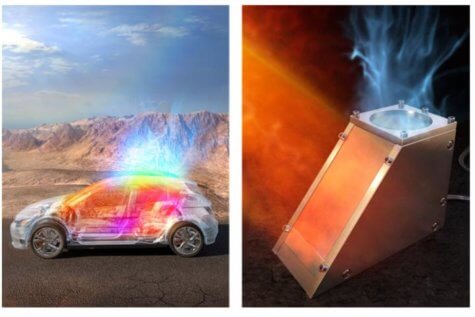GWANGJU, South Korea — If you’ve ever opened a car door on a summer day you know how dangerously hot it can be in there. Scientists in South Korea say they’ve developed a device which can soak up all this hazardous heat without even needing to be plugged in.
A team from Gwangju Institute of Science and Technology (GIST) call their invention the “Janus emitter,” or JET. It’s made of a stack of quartz, silver, and thin layers of a silicone polymer called polydimethylsiloxane.

The study reports that each side of the JET uses unique properties to passively cool enclosed spaces. The bottom absorbs a wide range of thermal radiation from tight spaces, like a hot car, and expels the energy back into the atmosphere from the top side.
“By separating the radiation characteristics from the upper and lower surfaces based on metallic silver (Ag) that strongly reflects sunlight (more than 90%), the lower surface absorbs heat in a closed space and releases the absorbed heat through the upper surface. This is why it was named the Janus emitter after Janus, the god of two faces in Roman mythology,” study authors write in a press release.
How hot can it get inside a car?
When it comes to hot (and potentially deadly) car interiors, researchers say sunlight easily passes through a vehicle’s windows. The problem with this thermal radiation is once it’s in, it can’t get back out. This creates a “greenhouse effect” inside the car which can drive temperatures as high as 180 degrees Fahrenheit. For the elderly and young children, this puts them at extreme risk for heatstroke and hyperthermia.
Without the need for electricity, the Korean team says the Janus emitter can lower the temperature inside a vehicle by over seven degrees Fahrenheit. They add that their device may be the starting point for manufacturers to build vehicle roofs which soak up all this solar radiation and expel it from parked cars.
“Our work is the first to address passive radiative cooling for enclosed spaces, and we hope it creates a ripple effect that bolsters research in this field,” Prof. Young Ming Song says in a media release.
The team adds the Janus emitter is also a sustainable way to keep building interiors and solar cells from overheating.
The study appears in the journal Science Advances.

I woke up wondering if there are gadgets out there that can cool vehicles without using energy.. then virtually transfer the saved heat to a solar light bulb..I live along the Indian Ocean coast and it gets very hot. .